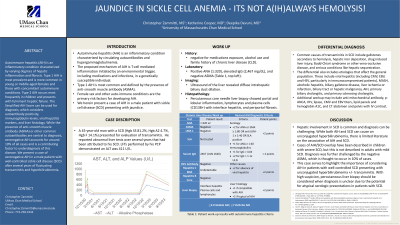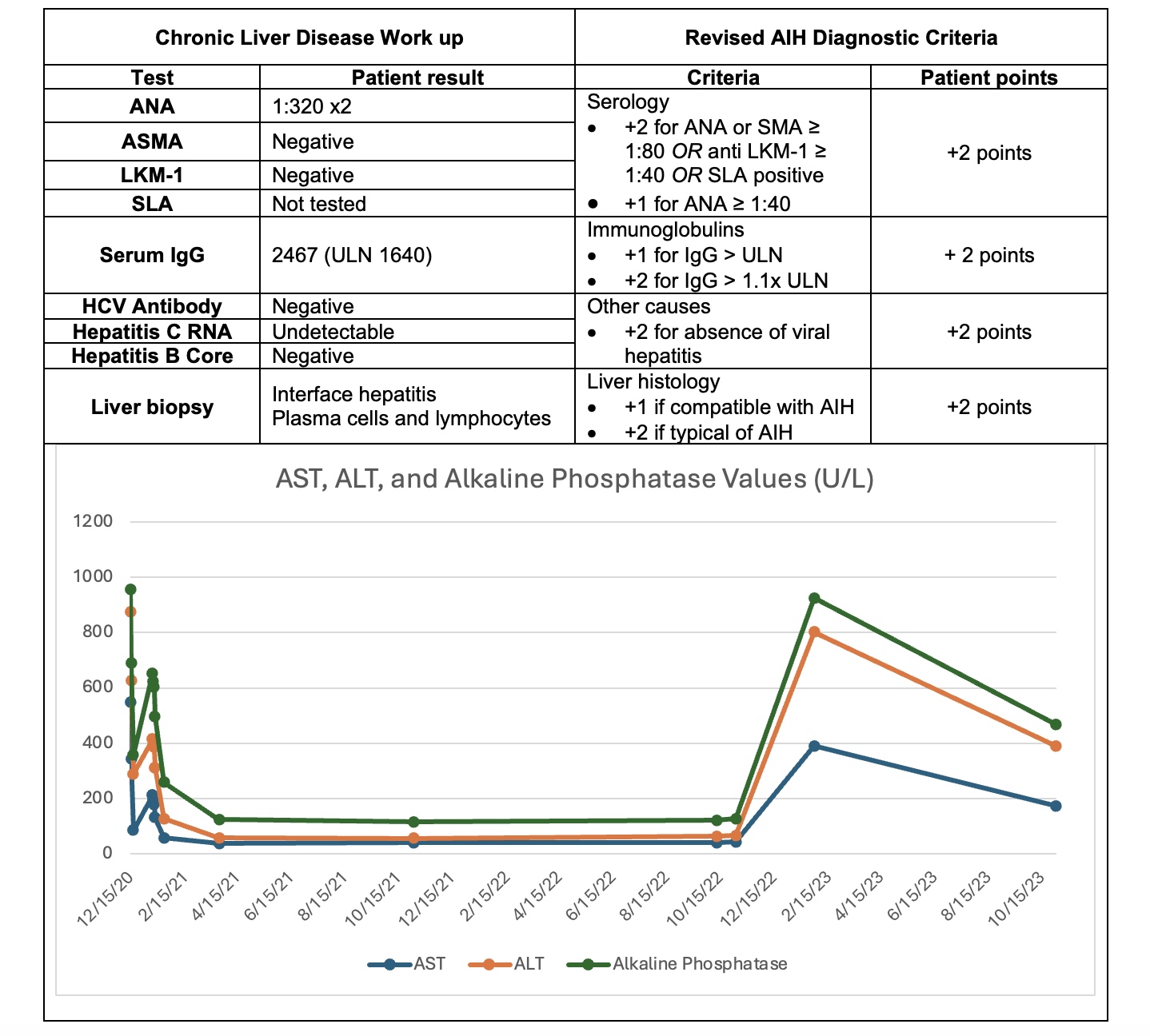Monday Poster Session
Category: Liver
P3032 - Jaundice in Sickle Cell Anemia - It's Not A(IH)always Hemolysis!
Monday, October 28, 2024
10:30 AM - 4:00 PM ET
Location: Exhibit Hall E

Has Audio

Christopher A. Zammitti, MS
UMass Chan Medical School
Worcester, MA
Presenting Author(s)
Christopher A. Zammitti, MS1, Katherine Cooper, MD2, Deepika Devuni, MD3
1UMass Chan Medical School, Worcester, MA; 2University of Massachusetts Chan Medical School, Worcester, MA; 3University of Massachusetts Memorial Medical Center, Worcester, MA
Introduction: Autoimmune hepatitis (AIH) is an inflammatory condition characterized by circulating autoantibodies and hypergammaglobulinemia. Female sex and other auto-immune conditions are the risk factors for developing AIH. We herein present a case of AIH in a male patient with SCD presenting with jaundice.
Case Description/Methods: A 45-year-old man with a SCD (Hgb SS 81.2%, Hgb A2 4.7%, Hgb F 14.1%) presents for evaluation of transaminitis. He reports abnormal liver tests starting few years ago that have been attributed to his SCD. At that time, he had a total bilirubin 5.3 mg/dL (indirect 4.6 mg/dL) with interval fluctuating transaminitis (Table 1, bottom). His most recent ALT was 411 U/L which prompted referral to hepatology for further investigation. Detailed history is negative for medications exposure, alcohol use and family history of chronic liver disease (CLD). A complete work up for CLD revealed positive ANA (1:320), elevated IgG (2,467 mg/dL), and negative anti-smooth muscle antibody (ASMA) (Table 1, top left). Ultrasound of the liver revealed diffuse intrahepatic biliary duct dilation. Percutaneous core needle liver biopsy showed portal and lobular inflammation, lymphocytes and plasma cells (CD138+) with interface hepatitis, and periportal fibrosis. He met criteria for definitive diagnosis based on 8 points in the AIH Simplified Criteria (Table 1, top right). Treatment was initiated with 60 mg of prednisone daily but was complicated by avascular necrosis of the femoral heads and acute chest syndrome requiring packed RBC transfusion for which transitioned to azathioprine with good effect.
Discussion: Hepatic involvement in SCD is common and diagnosis can be challenging. Common causes of transaminitis in SCD include gallstones, hepatic iron deposition, and serious conditions like hepatic sequestration. While both AIH and SCD can cause an unconjugated hyperbilirubinemia, there is limited literature on the association of AIH and SCD. Cases of AIH/SCD overlap have been described in children with severe SCD, but this is not described in adults with mild SCD. Diagnosis was further challenged by the negative ASMA, which is generally see in women. This case serves to highlight the importance of considering AIH in patients with well-controlled SCD presenting with unconjugated hyperbilirubinemia +/- transaminitis. With high suspicion, percutaneous liver biopsy should be considered when diagnosis is unclear due to the potential for atypical serologic presentations in patients with SCD.

Disclosures:
Christopher A. Zammitti, MS1, Katherine Cooper, MD2, Deepika Devuni, MD3. P3032 - Jaundice in Sickle Cell Anemia - It's Not A(IH)always Hemolysis!, ACG 2024 Annual Scientific Meeting Abstracts. Philadelphia, PA: American College of Gastroenterology.
1UMass Chan Medical School, Worcester, MA; 2University of Massachusetts Chan Medical School, Worcester, MA; 3University of Massachusetts Memorial Medical Center, Worcester, MA
Introduction: Autoimmune hepatitis (AIH) is an inflammatory condition characterized by circulating autoantibodies and hypergammaglobulinemia. Female sex and other auto-immune conditions are the risk factors for developing AIH. We herein present a case of AIH in a male patient with SCD presenting with jaundice.
Case Description/Methods: A 45-year-old man with a SCD (Hgb SS 81.2%, Hgb A2 4.7%, Hgb F 14.1%) presents for evaluation of transaminitis. He reports abnormal liver tests starting few years ago that have been attributed to his SCD. At that time, he had a total bilirubin 5.3 mg/dL (indirect 4.6 mg/dL) with interval fluctuating transaminitis (Table 1, bottom). His most recent ALT was 411 U/L which prompted referral to hepatology for further investigation. Detailed history is negative for medications exposure, alcohol use and family history of chronic liver disease (CLD). A complete work up for CLD revealed positive ANA (1:320), elevated IgG (2,467 mg/dL), and negative anti-smooth muscle antibody (ASMA) (Table 1, top left). Ultrasound of the liver revealed diffuse intrahepatic biliary duct dilation. Percutaneous core needle liver biopsy showed portal and lobular inflammation, lymphocytes and plasma cells (CD138+) with interface hepatitis, and periportal fibrosis. He met criteria for definitive diagnosis based on 8 points in the AIH Simplified Criteria (Table 1, top right). Treatment was initiated with 60 mg of prednisone daily but was complicated by avascular necrosis of the femoral heads and acute chest syndrome requiring packed RBC transfusion for which transitioned to azathioprine with good effect.
Discussion: Hepatic involvement in SCD is common and diagnosis can be challenging. Common causes of transaminitis in SCD include gallstones, hepatic iron deposition, and serious conditions like hepatic sequestration. While both AIH and SCD can cause an unconjugated hyperbilirubinemia, there is limited literature on the association of AIH and SCD. Cases of AIH/SCD overlap have been described in children with severe SCD, but this is not described in adults with mild SCD. Diagnosis was further challenged by the negative ASMA, which is generally see in women. This case serves to highlight the importance of considering AIH in patients with well-controlled SCD presenting with unconjugated hyperbilirubinemia +/- transaminitis. With high suspicion, percutaneous liver biopsy should be considered when diagnosis is unclear due to the potential for atypical serologic presentations in patients with SCD.

Figure: Table 1: Chronic liver disease work up (top left) with autoimmune hepatitis criteria (top right) and liver marker profile over time (bottom)
Disclosures:
Christopher Zammitti indicated no relevant financial relationships.
Katherine Cooper indicated no relevant financial relationships.
Deepika Devuni: Massachusetts Department of Public Health – Grant/Research Support. National Institute on Alcohol Abuse and Alcoholism – Grant/Research Support. Sequana Medical – Grant/Research Support.
Christopher A. Zammitti, MS1, Katherine Cooper, MD2, Deepika Devuni, MD3. P3032 - Jaundice in Sickle Cell Anemia - It's Not A(IH)always Hemolysis!, ACG 2024 Annual Scientific Meeting Abstracts. Philadelphia, PA: American College of Gastroenterology.
